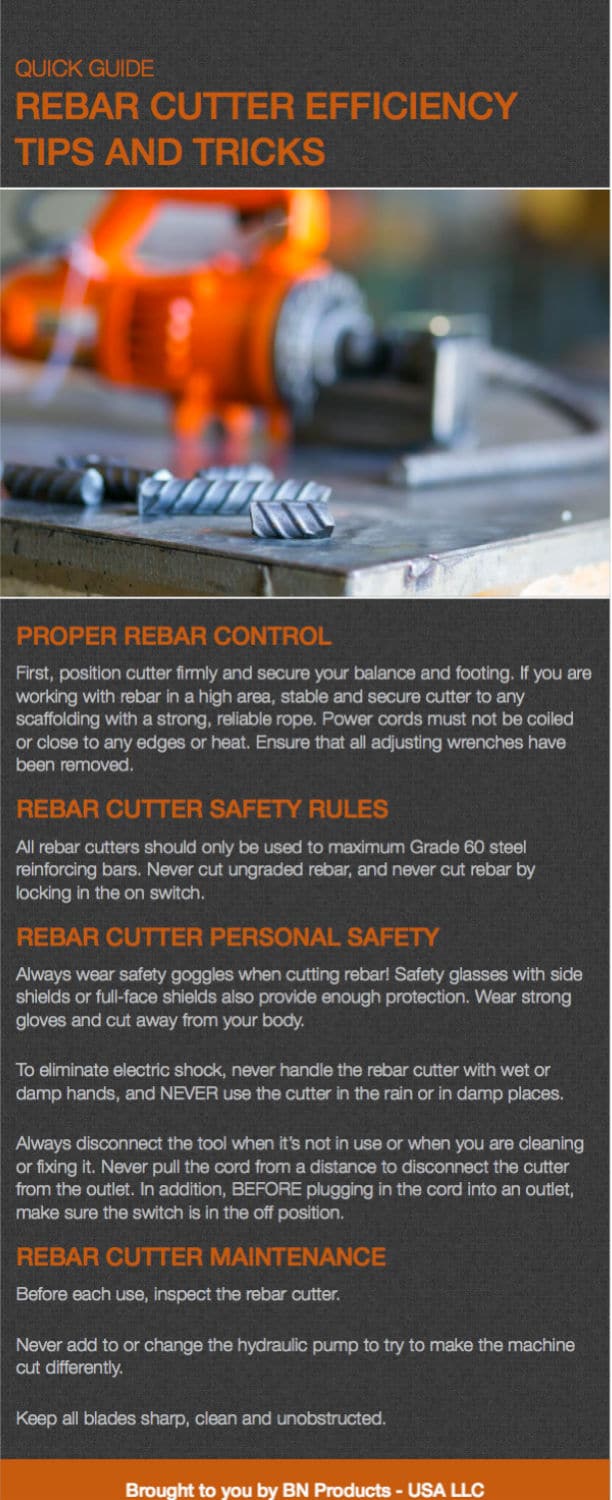 When you invest in a new rebar cutter, you’re not purchasing a new tool, you’re making an investment into job progress and rebar cutter efficiency. When taken care of, a proper rebar cutter will cause any rebar with which you have to work easier and quicker to cut. There are certain steps that need to be taken to ensure your rebar cutter works reliably and lasts a long time.
When you invest in a new rebar cutter, you’re not purchasing a new tool, you’re making an investment into job progress and rebar cutter efficiency. When taken care of, a proper rebar cutter will cause any rebar with which you have to work easier and quicker to cut. There are certain steps that need to be taken to ensure your rebar cutter works reliably and lasts a long time.
Proper Rebar Control
When you use your rebar cutter, it is essential that you maintain complete control and safety precautions. First, position cutter firmly and secure your balance and footing. If you are working with rebar in a high area, stable and secure cutter to any scaffolding with a strong, reliable rope. Power cords must not be coiled or close to any edges or heat. Ensure that all adjusting wrenches have been removed.
Rebar Cutter Safety Rules
Most BNProducts rebar cutters should only be used to maximum Grade 60 steel reinforcing bars. Never cut ungraded rebar, and never cut rebar by locking in the on switch. In colder climates, this locking position is used to warm the tool. Locking in the on switch to cut rebar can be dangerous, and it can also break or damage the cutter. Always utilize the on/off switch manually for each cut. Sometimes, there are foot-operated switched and electrical boxes you can use if you are using the cutter for production.
If you use your rebar cutter to cut any other type of rebar, there is a chance that the cut end may expel (especially if it’s less than a foot long). If you go over the specific material specifications, you can also increase this risk and increase the risk of damaging the cutter. Never try to cut rebar that is tougher, thicker or thinner than the machine is designated to cut.
Rebar Cutter Personal Safety
Always wear safety goggles when cutting rebar! Safety glasses with side shields or full-face shields also provide enough protection. Wear strong gloves and cut away from your body. Another precaution that must be followed is to protect the areas and other contractors near the rebar by building safety screens under the rebar.
To eliminate electric shock, never handle the rebar cutter with wet or damp hands, and NEVER use the cutter in the rain or in damp places. Before cutting, take note of all power outlets, lines and circuits that could be contacted as you cut. On many jobs, it is especially important to first take not of all power lines that are underneath the ground or hidden from your view. Also, don’t handle the tool by its cord.
Always disconnect the tool when it’s not in use or when you are cleaning or fixing it. Never pull the cord from a distance to disconnect the cutter from the outlet. In addition, BEFORE plugging in the cord into an outlet, make sure the switch is in the off position.
Always remove any adjusting keys or wrenches BEFORE turning on the cutter.
Ensure the switch is always in the off position before plugging in and always carry the tool with the switch to off.
Again, never cut ungraded rebar.
Rebar Cutter Maintenance
Before each use, inspect the rebar cutter. If any part of the cutter is loose or looks broken, the result could be injury to you or others or damage to the rest of the machine. When you inspect the machine, make sure your hands are clean and dry. Make sure there is no dirt or iron fillings in the housing and piston, and always inspect the housing for cracks or breaks. Inspect all bolts and screws; have replaced when necessary. Check that the switchs cords and plugs are never damaged. If plugs and extension cords are damaged, do not use.
Never add to or change the hydraulic pump to try to make the machine cut differently.
Keep all blades sharp, clean and unobstructed. When a cutting tool or blade is cleaned and maintained, edge are less likely to bind.
Rebar Cutter Bleeding
If your rebar cutter begins to run slow or loses pressure, it may be time to bleed the machine’s hydraulics. Never use your rebar cutter when the oil is low. To bleed your rebar cutter, follow these steps:
- For moving pistons, run the cutter for a couple minutes to warm the oil. For unmoving pistons, add oil, then warm.
- With warm oil, run the piston before it returns and stop.
- Remove oil plug; top off oil.
- Cover the oil plug opening, and turn on the cutter for a complete cycle.
- When the piston is retracted to the open position, let air out of the plug opening gently. Repeat these steps 2 or 3 times.
- Only ever add more oil when the piston is at least halfway out. If you still have additional oil, repeat these steps.
- Replace oil plug.
- Cut a few pieces of rebar to observe how the machine is working. Take note of where the rebar breaks, then pinch rebar and STOP before it breaks.
- Remove oil plug, top off once more, replace plug and seal.
For more information about rebar cutters and to find one that fits your needs, contact BN Products today.


